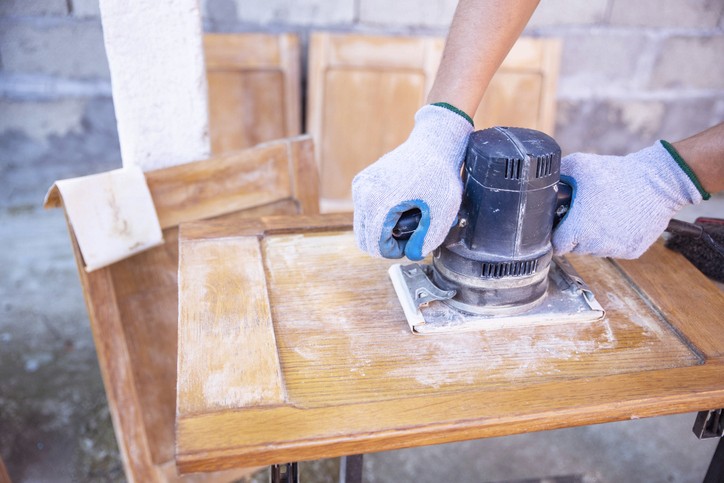How To Sand Kitchen Cabinets
Your kitchen cabinet's paint job may come off because of wear and tear, damage, or simply a change in design preference. In such cases, sanding your kitchen cabinets is the best choice to give them a new look. Sanding cabinets removes old paint, stain, or finish and ensures a smoother finish, allowing for better paint adhesion.
Understanding the basics of sanding is needed to achieve excellent results and prevent issues such as uneven surfaces or peeling paint. With the right techniques and tools, you can modify your kitchen cabinets into a stunning focal point in your home.
How to Sand Cabinets the Right Way
1. Gather Your Materials
Make sure you gather the necessary tools before proceeding. Having everything at hand will streamline the process and ensure safety. The tools you will need include:
A sheet of sandpaper (80, 120, and 220 grit)
Sanding block or electric sander
Vacuum or brush
Damp, microfiber cloth
Safety gear (goggles and dust mask)
2. Remove Hardware and Doors
To achieve an even finish, remove the drawers, cabinet doors, and other hardware, such as knobs and hinges. This surface preparation will make the sanding process easier and prevent damage to parts that should not be sanded.
3. Clean the Surfaces
Wipe the cabinets using a damp, microfiber cloth to remove dust, grease, and debris. Let the surfaces dry out completely. A clean surface is needed to make the sanding effective and let the wet paint stick better.
4. Choose the Right Grit Sandpaper
Start with a coarser grit (80 or 100) to efficiently remove the existing finish. A coarser grit can save time and effort for surfaces with stubborn paint or finish. Progressively move to finer grits (120 and then 220) for a smooth finish.
5. Sand in the Grain's Direction
Always sand in the direction of the wood grain to avoid scratches and achieve a smooth, polished look. If you're using a sanding block, apply even pressure to ensure consistent results across the flat surface. Let the tool do the work to prevent over-sanding when using an orbital sander.
6. Check for Smoothness
After sanding with each grit, run your hand over the surface to check for smoothness. If a rough texture remains, repeat light sanding with the appropriate grit until the surface is smooth.
7. Clean Up Dust
After completing the sanding process, thoroughly vacuum the surfaces to remove dust particles. Use a damp cloth to wipe down all sanded areas again, ensuring a clean surface for painting.
8. Inspect the Surface
Before painting or staining, inspect the cabinets for missed areas or imperfections. Ensure that the surfaces are completely smooth and free of dust, as any leftover debris can impact the finish of the new coats of paint.
What Are the Costs of Sanding a Kitchen?
Materials Costs
Sandpaper. Different grits of sandpaper are required for effective sanding. Expect to spend around $10 to $30 for a variety pack covering grits 80, 120, and 220.
Sanding Tools. If you don't have sanding tools, you may need a sanding block or an orbital sander. A sanding block is inexpensive, typically around $5, while electric sanders can range from $30 to $150, depending on the model and brand you choose.
Cleaning Supplies. A vacuum or brush for dust removal and damp cloths for cleanup usually add about $5 to $10 to your costs.
Safety Equipment
Investing in safety gear protects yourself during the sanding process. Safety goggles and a dust mask can cost around $15 to $30. Wearing these items helps avoid inhaling dust particles and protect your eyes from debris.
Labor Costs
DIY Approach. If you choose to do it yourself, you can save on labor costs but should account for the time spent. Completing the sanding can take several hours, depending on the cabinets' number and condition.
Hiring a Professional. If you prefer to hire someone, the cost can vary widely. Professional sanding services typically charge between $30 to $75 per hour. For a complete kitchen cabinet sanding job, you might expect to pay between $200 and $600, depending on the size and complexity of the project. You can always get a quote from multiple contractors to widen your choices.
Finishing Costs (Optional)
Once the sanding is complete, you may also want to factor in the costs for finishes, such as paint or stain, which range from $20 to $75 per gallon. Don’t forget brushes or rollers, that will cost you around $10 to $20.
What Types of Kitchen Cabinets Can You Sand?
Wood Cabinets. Wood cabinets are the most common type, easily sanded down to a smooth finish. Solid wood, like oak, maple, or cherry, responds well to sanding and can be refinished multiple times. However, sand must be used carefully to maintain the wood grain's integrity.
Veneer Cabinets. Veneer cabinets are made from a thin layer of natural wood applied over a composite base. While they can be sanded, the procedure must be cautiously approached, as excessive sanding can strip away the veneer layer. It’s best to use finer grit sandpaper to minimize the chances of cabinet damage.
MDF (Medium-Density Fiberboard) Cabinets. MDF cabinets are non-wood composite products that can be sanded smoothly. They usually have a smooth surface that accepts paints and finishes very well. While sanding MDF, be mindful that it generates a ton of fine dust, so you may need to wear appropriate safety gear, like a full-face respirator.
Laminate Cabinets. Laminate cabinets have a plastic coating over particle boards or plywood, challenging the sanding process. While it's possible to lightly sand laminate surfaces to prepare for the painting cabinet process, severe sanding can cause damage. Instead, a thorough cleaning and priming may be more effective.
Metal Cabinets. Metal cabinets are less common in modern kitchens, but if you have them, they can also be sanded to remove rust, scratches, or old paint. Use a sanding sponge or grinder for larger areas. With metal, it’s important to apply a primer afterward to prevent rusting before adding a top coat of paint.
Install Newer Kitchen Cabinets by Choosing Collaborative Kitchen & Design Center in Massachusetts!
If your cabinets need replacing rather than sanding, you can always turn to Collaborative Kitchen & Design Center for quality and elegant kitchen cabinets. You can choose from our extensive collection, each manufactured with quality and care in mind. And if you're confused about which kitchen cabinet you need, we can provide you with detailed explanations!
You may also visit our showroom in Marlborough to get a closer look at our many variants of kitchen cabinets. Don't forget that you can also hire us for the installation job once you've chosen your preferred kitchen cabinets. Keep in mind we normally operate around Worcester, Framingham, Foxborough, and Southborough.
Contact us now to talk with our kitchen cabinet experts and create the kitchen of your dreams today!










